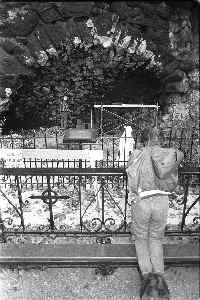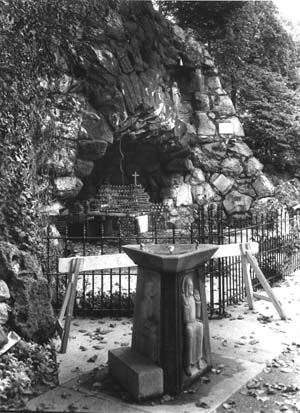
Notre Dame's Grotto / by Dorothy V. Corson

A Fire Sparks Renewed Interest in the Grotto
 This story would also not be complete without a description of the almost disastrous fire at the Grotto, in the predawn hours of September 23, 1985, when the Grotto was loaded with lighted candles, said to be some 1500, during a Michigan State game,which Notre Dame won 27-10. Though a sad occasion, the attention focused on the Grotto initiated many expressions of heartfelt feelings about it.
This story would also not be complete without a description of the almost disastrous fire at the Grotto, in the predawn hours of September 23, 1985, when the Grotto was loaded with lighted candles, said to be some 1500, during a Michigan State game,which Notre Dame won 27-10. Though a sad occasion, the attention focused on the Grotto initiated many expressions of heartfelt feelings about it.
This firsthand account of the fire came from Brother Borromeo Malley, who was fire chief at the time. He has been associated with the Notre Dame campus for 60 years and is now retired and living at Holy Cross House on campus.
He was sitting in the Clinic lobby at Holy Cross House. He said he was getting ready to leave, when he noticed the road was congested with cars from an accident in front of Moreau Seminary. He had decided to wait until it cleared. Then he grinned, mischievously, and added, "The only thing I have to do in this life is die, and I can do it just as well here as out there." A conversation about the Grotto fire flowed from that happenstance meeting.
 Brother Borromeo, straightforward and friendly, had a terrific memory for details. This is the story he related about the Grotto fire which he compared to a refinery or oil fire:
Brother Borromeo, straightforward and friendly, had a terrific memory for details. This is the story he related about the Grotto fire which he compared to a refinery or oil fire:
It was one hell of a fire; heavy black smoke belched from the opening of the Grotto. The heat was so intense that when water came in contact with the stone, it caused spalling, which happens when the stones become overheated and chip or fall off in blocks. Large pieces lay on the ground in front of the rocks.
Candles grouped on the floor of the grotto, for lack of holder space, had ignited their plastic containers causing a fire. The candle racks had been pushed back, over other burning candles, to make room for more on the floor and the ones below had ignited those above them."
As Brother Borromeo put it, "It looked like one big mess of molten molasses."
The fire left battle scars on the Grotto but did not bring it down. Only a limited number of candles are allowed to burn there now, and glass containers have replaced the plastic ones. The singed ivy and blackened trees, on the front and above the Grotto, have already grown back; and the statue, although smudged with smoke, miraculously escaped unharmed. Since the smoke damage to the stones required professional cleaning, the fire turned out to be a providential improvement. It was speedily refurbished and repaired leaving only a slightly changed appearance. The darkened interior stones, freshly cleaned of almost 90 years of candle smoke, are kept that way now by a professional cleaning on a regular basis.
It was a timely encounter; Brother Borromeo died less than a year later. Father Schidel related this typical Brother Borromeo comment in describing his last hours on earth. He was having breakfast with him that morning. They were discussing the fatal airliner crash in Japan, that had just been reported on the news, when Brother Borromeo made the comment: "Well, the next trip I'm going to take is going to be my last!" and he pointed toward heaven.
A few hours later, on Tuesday, April 26, 1994, in the midst of a conversation, Brother Borromeo was taken from this world by a sudden heart attack. He was 81. The previous Friday he was his usual friendly, outgoing self, full of vigor. His "I can die just as well here, as out there," spoken in the clinic waiting room at Holy Cross House the day he described the fire at the Grotto, came to mind. He collapsed and died in the same room.
The expansion and updating of the Notre Dame fire department was due largely to his efforts. Brother Borromeo Malley, who retired after 50 years of service, was honored as the longest surviving fire chief in the United States in 1992.